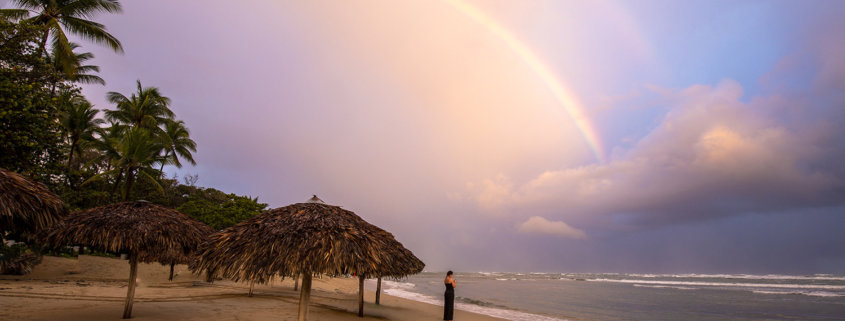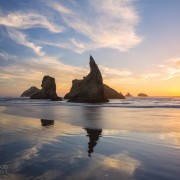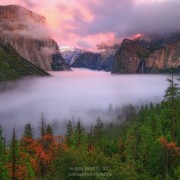A Beginners Guide for Creating Fine Art Prints
We can’t deny the fact that the latest smartphone cameras have made some remarkable achievements in developing a decent landscape photography image quality, especially if these images are only being used on social media sites. Although there are a lot of innovative algorithms that create landscape photography images that look similar to those from a DSLR on screen, have you ever tried to create a fine art print from your smartphone or your DSLR, only to be disappointed with the results?
There are many factors that affect how well smartphone or camera images print. So, before we get into the steps to getting colors right for fine art prints, let’s look at a few important steps needed to capture the image correctly before the printing stage (the first two steps below).
Step 1: File Formats for Fine Art Prints
An image file format describes how data related to the image is stored and most importantly, how much data is retained. Landscape photography image data can be stored in compressed and uncompressed format. Each format has its advantages and disadvantages.
As a landscape photographer, you probably shoot in Raw or Jpeg, or sometimes both. And then you usually edit the image in Photoshop, Adobe Camera Raw, or Lightroom. Then you save your image. How do you save it? Do you save as a PSD, Tiff. or Jpeg?
JPEG format is meant for transmitting photos over networks and showing on screens. It sheds a lot of the (unrecoverable) original data that was captured by your camera. In this format, the camera processes the appearance of the photo; your scope for further manual editing remains but is greatly reduced. When using a JPEG, I always use the highest quality setting for saving the file.
For fine art prints I use a TIFF file format to save all my travel or landscape photos. You will also want to save your work as a Photoshop PSD or a TIFF file format when you have Photoshop layers that you want to preserve. These formats allow for uncompressed saving with no loss of data and are preferred for high quality fine art prints – especially large ones.
Step 2: Resolution for Fine Art Prints
Image resolution in digital photography has a technical metric: pixels per inch (ppi) of image dimensions. Higher resolution doesn’t necessarily mean sharper landscape photos – that also depends very much on camera lenses, camera sensors, focus setting, and other factors.
So, what is a good resolution for printing a photo? We recommend something in the range of 300 to 360 pixels per inch for landscape photography prints created using Canon, HP, or Epson photographic printers. The total pixel dimensions determine the linear image dimensions you can have at those resolution values. Keep in mind that you can also resample the images in Photoshop in order to change linear dimensions at a given resolution or work with lower resolution.
So how big can I print my photos? This can easily be measured in Photoshop or other post-processing software. For example, I shoot with a Canon 6D full frame 20.2MP camera. When I shoot in RAW file format, it creates a 57.1M file size. If I create an 300 ppi image, I receive a 12×18″ print at 300 ppi. Depending on the image, I might at times work with a 200 ppi file size. In this case, I receive an 18×27″ print from the printer. Note that if you send more or less resolution to the printer than the printer’s native resolution calls for, the print process resamples your file on the fly to match this native resolution. When printing large landscape photos, the quality of the photo itself and the pixel dimensions count.
Step 3: Calibrate Your Monitor
One of the most important steps for creating fine art prints is to have a high enough quality monitor that can be properly calibrated and profiled. The monitor is your only insight into the photo until it emerges from the printer. There are several software packages that you can use to calibrate basic parameters for your monitor (such as white point, black point, contrast ratio, brightness) and then, with that calibration in hand, create a profile consistent with the calibration parameters. These packages include X-Rite i1Display Pro or X-Rite ColorMunki , but there are others as well.
Also, it’s helpful to view photos on a monitor in a properly lit room in order to minimize the impacts of distraction and the appearance of diluted color from too much ambient light hitting the display. There is an appropriate balance to strike between the levels of monitor brightness and ambient light. If you find that this level of management isn’t meeting your requirements or expectations, you may want to investigate the issues and re-calibrate your monitor.
Step 4: Sharpen your Photos
No matter how carefully a landscape photographer sets up the exposure and composition, photos often require a few tweaks. One of the most important post-processing adjustments for creating a professional looking landscape photography prints is sharpening. Some landscape photographers prefer Photoshop to do this and some prefer Lightroom.
It is important to remember that an image captured by DSLR or mirrorless camera goes through many stages before it’s printed. From the lens to the sensor, through the software processing, some of these steps can soften or degrade your image. So, sharpening can improve your fine art print, although, if done correctly, won’t affect color accuracy in any way.
One of my favorite sets of Photoshop filters to sharpen comes from Sharpener Pro from NIK. Sharpener Pro is a photo editing plugin offering two stages of sharpening. The first stage is RAW Pre-Sharpener, a tool to extract the correct level of detail from a photo. The second stage is Output Sharpening, which can adjust an image for its intended destination, whether it’s for a fine art print or a screen.
Step 5: Setup Color Management Using Printer Profiles
Canon, HP, and Epson offer a type of turn-key solution, especially when using their media. These printers have built-in profiles for correctly printing their own media. They have also developed their printer drivers over the years to accommodate third-party media. Using manufacture’s papers and printer profiles do provide a turn-key solution producing good quality prints right out of the box. If you decide to go this route, you should select let printer manage color in Photoshop or Lightroom.
If you feel you need yet better results from your printer, then you would let Photoshop manage color and use custom profiles for your printer & paper combinations. Most professional landscape photographers will choose to let Photoshop manage colors and will often use custom profiles.
It’s not within this article’s scope to go into the details of making or using such profiles or custom profiles, but there are numerous articles that have been written on the subject. If you need to use a custom media profile, there are many companies that provide this service on-line. Alternatively, you can invest in X-Rite (or other) professional color management software and hardware.
Step 6: Choose Your Media
I like to print at home because I can experiment with a large range of available media types. There isn’t just one “best” paper. It really comes down to how you think it suits the image, what you like, and how it looks and feels to you. If you get hold of a good media supplier, they should be able to provide sample packs from manufactures such as Canon, HP, Epson, Moab, Red River, Hahnemühle, and so on.
Step 7: Choose Your Printer
There is quite a range of inkjet printers on the market today. Some office-type printers may give you a nice-looking image, but not all inkjet printers are created equally. The most usual and accessible brands currently on the market are from Canon, HP, and Epson. All of these manufacturers can make fine prints and all have their pros and cons.
If you are looking at Canon, then you’ll want to consider Canon imagePrograf photo printers starting with the 17” wide Pro1000 and going all the way up to 60” imagePrograf 6100. The Epson photo printers start with the 17” SureColor P800 and going all the way up to 64” Epson SureColor P20000. All three manufacturers also offer 24” and 44” models.
In summary, digital imaging makes fine art printing more accessible than ever in the history of photographic technology. However getting color and sharpening correct is usually essential for creating outstanding landscape photography prints. You can approach this at different levels of ease or complexity, depending on your requirements and taste. The main point of this very brief overview into a vast subject is that you have choices whether to start at an elementary automated level where most of the work is done for you under the hood, or to move into processes and procedures over which you exercise more control and may get better results, but need to learn more and experiment more.
Do you have questions about creating fine art prints? Feel free to leave them in the comments below.
Many thanks to Mark Segal who provided advice for this article. Mark’s been making photographs for the past six decades. He’s an author, educator, and communicator in several fields and has a great knowledge in creating fine art prints with inkjets.
















